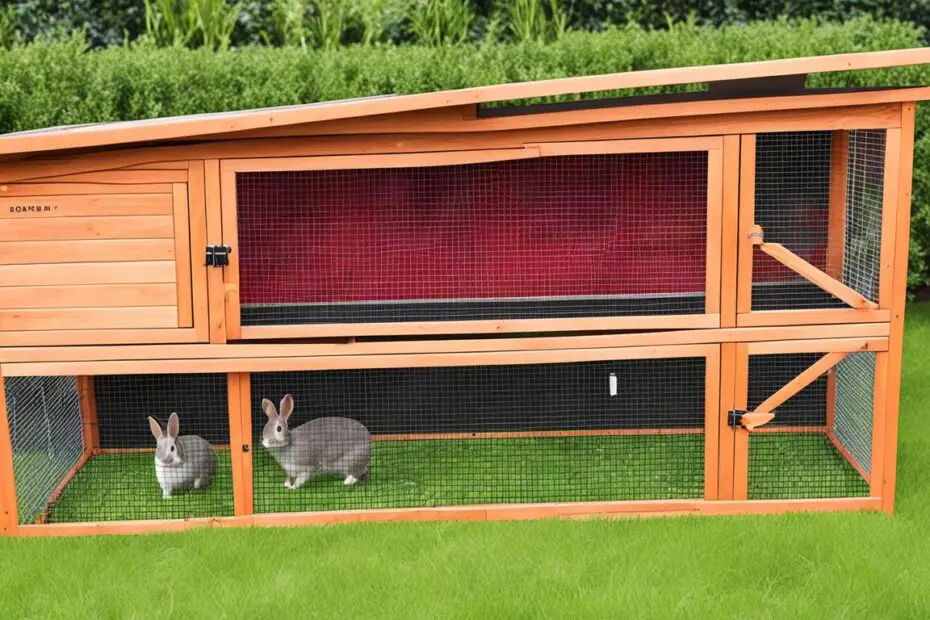Raising meat rabbits is a popular choice for breeders and homesteaders looking to provide their own sustainable source of meat. To ensure the success of your breeding program, it’s important to invest in a high-quality meat rabbit hutch. In this article, we’ll explore the best options available, focusing on durability, spaciousness, and meeting the specific needs of meat rabbits.
Key Takeaways:
- Investing in a high-quality meat rabbit hutch is essential for successful breeding programs.
- Durability, spaciousness, and meeting meat rabbits’ specific needs are important considerations when choosing a hutch.
- Meat rabbits require comfortable and secure housing to ensure their well-being and growth.
- Selecting the right hutch will help breeders achieve optimal meat to bone ratios and breeding capabilities.
- By providing a suitable hutch, breeders can contribute to a sustainable source of meat for their communities.
Benefits of Raising Rabbits for Meat
Raising rabbits for meat has numerous advantages, particularly for those with limited space in urban or suburban environments. Whether you choose an indoor or outdoor housing option, investing in a well-designed meat rabbit cage or hutch is essential for the comfort and well-being of your rabbits. Not only do these housing options provide the necessary space for your rabbits to move around freely, but they also offer benefits in terms of easy maintenance and cleaning.
When it comes to meat rabbit housing, there are two main options: indoor rabbit hutches and outdoor rabbit cages. Indoor rabbit hutches are perfect for those looking to raise rabbits in a controlled environment, such as a basement or garage. These hutches are designed to be spacious and comfortable, allowing your rabbits to exercise and rest comfortably.
On the other hand, outdoor rabbit cages provide a suitable option for breeders who prefer to establish their rabbitry in the backyard or garden. Outdoor cages offer the advantage of a natural environment, allowing rabbits to experience fresh air and sunlight while still providing a secure and protected space.
Image:
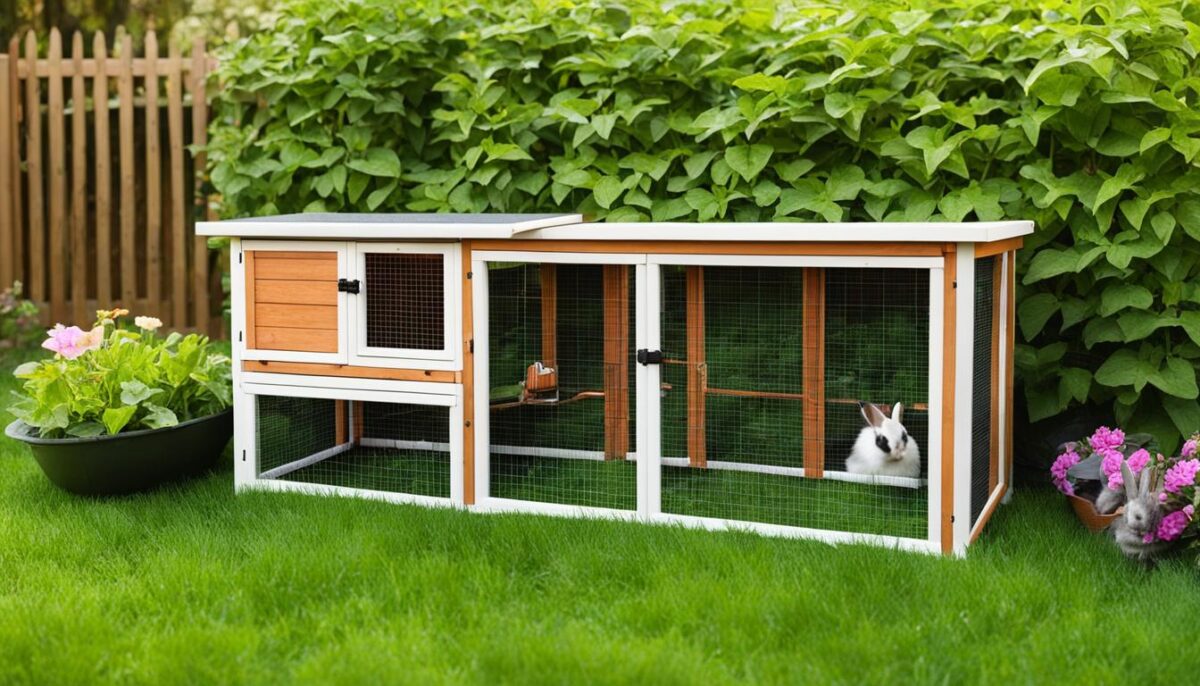
One of the key benefits of meat rabbit cages and hutches is their ease of cleaning. Regular cleaning is crucial to maintain a hygienic living environment for your rabbits and prevent the buildup of waste. Both indoor hutches and outdoor cages can be designed with features that facilitate efficient cleaning, such as removable trays or easy access to all areas of the housing. This not only saves time and effort but also helps prevent the spread of diseases and ensures the overall health of your rabbits.
In summary, meat rabbit housing options, such as indoor rabbit hutches and outdoor rabbit cages, offer several benefits. They provide a suitable and comfortable living space for rabbits in both urban and suburban environments. Additionally, their ease of cleaning minimizes maintenance requirements and promotes the well-being of your rabbits.
Choosing the Right Meat Rabbit Breed
When it comes to selecting a meat rabbit breed, there are several factors to consider to ensure the success of your breeding program. Key considerations include the meat to bone ratio, pelt quality, and breeding capabilities of the doe and buck.
Popular meat rabbit breeds that meet these criteria include:
- New Zealands
- Rex
- Flemish Giants
- Florida White
- Californians
The choice of breed will depend on your specific goals and preferences. Each breed offers unique characteristics that can contribute to the success of your meat rabbit breeding program.
“Selecting the right meat rabbit breed is crucial for achieving optimal meat to bone ratios and breeding capabilities.”
When it comes to housing meat rabbits, providing a nesting box within the hutch is essential for the comfort and safety of the does during the birthing process. A rabbit hutch with a nesting box provides a secure and cozy space for the does to give birth and care for their kits.
There are various options available for purchasing meat rabbit hutches, with a range of prices to suit different budgets. Whether you’re looking for a rabbit hutch with a nesting box or a more affordable meat rabbit hutch, there are options available to meet your needs.
Example of a Meat Rabbit Hutch with Nesting Box
| Rabbit Hutch | Features | Price |
|---|---|---|
| Brand X | Nesting box, spacious design, easy to clean | $200 |
| Brand Y | Durable construction, ventilation, nesting box included | $250 |
| Brand Z | Affordable option, nesting box with removable divider | $150 |
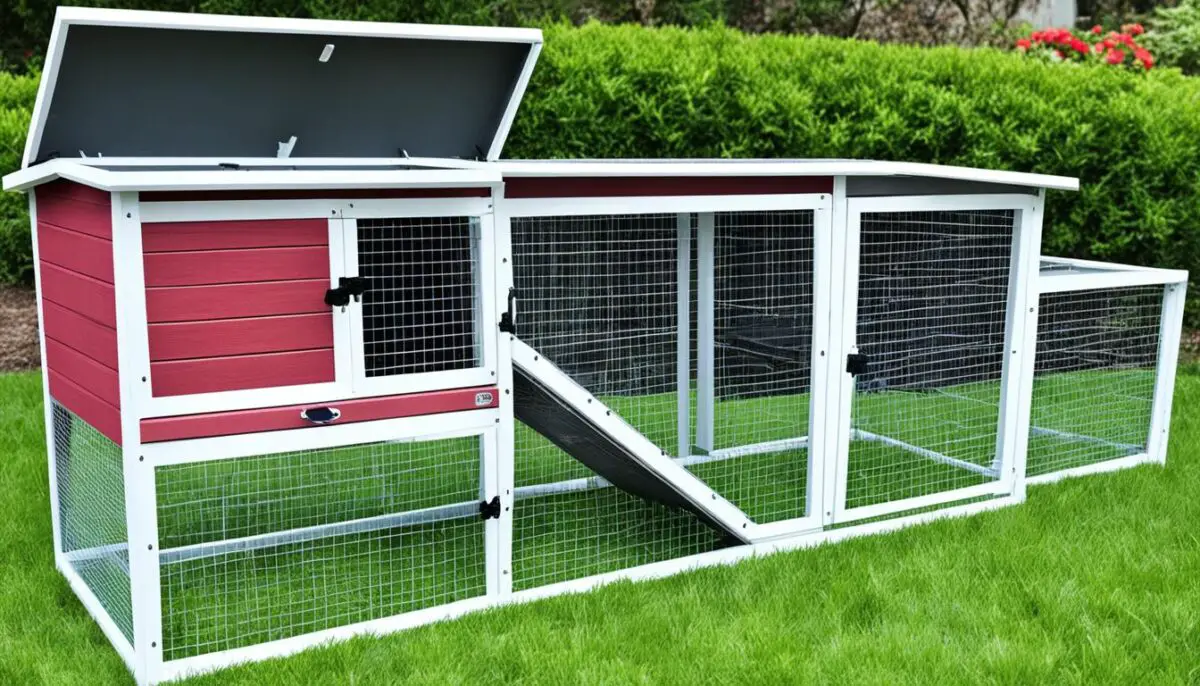
The table above showcases three different meat rabbit hutches with nesting boxes, providing a variety of features and price points. These options will ensure the comfort and well-being of your meat rabbits, allowing for successful breeding and raising of healthy kits.
Meat Rabbit Breeding and Growth
The process of meat rabbit breeding is straightforward and can lead to large litters of kits. A single buck has the ability to service multiple does in a day, maximizing breeding efficiency. The gestational period for rabbits typically lasts around 29-32 days, after which the does give birth to their kits. It is important to provide does with a rest period of 4-6 weeks between litters, allowing them to regain strength and properly nurse their current litter.
Meat rabbits reach their optimal butchering weight between 8-14 weeks of age, depending on the breed. During this growth period, it is crucial to provide them with a balanced diet and proper care to ensure their healthy development. Crossbreeding larger rabbit breeds with smaller ones can be beneficial for achieving the desired weight for fully dressed rabbits, maximizing the yield of meat.
If you’re considering meat rabbit breeding, it’s essential to monitor the rabbits’ growth and adjust their feed accordingly. Regular health checks and vaccinations are necessary to maintain the overall well-being of the rabbits. By following proper breeding techniques and providing quality care, breeders can successfully raise meat rabbits from birth to butcher.
| Breed | Optimal Butchering Age (weeks) |
|---|---|
| New Zealand Whites | 10-12 |
| Rex | 12-14 |
| Flemish Giants | 12-14 |
| Florida White | 10-12 |
| American Chinchilla | 12-14 |
| Californians | 8-10 |
| Cinnamon | 10-12 |
| Champagne D’Argent | 12-14 |
| Harlequin | 12-14 |
| Standard Chinchilla | 10-12 |
| Satin | 8-10 |
| American Blue | 10-12 |
| Palomino | 12-14 |
| Silver Fox | 12-14 |
Table: Optimal Butchering Age for Different Meat Rabbit Breeds
Excellent Meat Rabbit Breeds
When it comes to selecting meat rabbit breeds, breeders have a wide range of excellent options to choose from. Each breed offers its own unique characteristics that cater to different breeding goals and preferences. Here are 14 excellent meat rabbit breeds to consider:
- New Zealand Whites
- Rex
- Flemish Giants
- Florida White
- American Chinchilla
- Californians
- Cinnamon
- Champagne D’Argent
- Harlequin
- Standard Chinchilla
- Satin
- American Blue
- Palomino
- Silver Fox
These breeds offer a variety of sizes, meat to bone ratios, and pelt qualities, allowing breeders to select the most suitable options for their specific needs. Whether you prioritize fast growth, efficient meat production, or luxurious fur, there’s a breed that will meet your requirements.
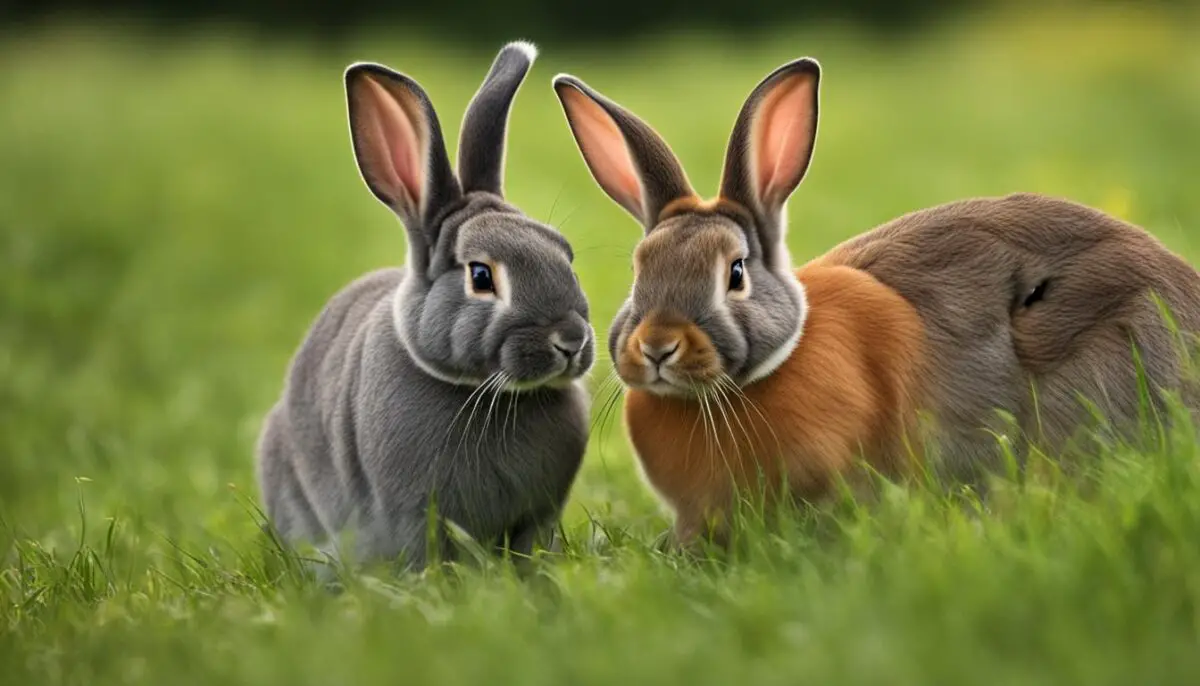
Housing Options for Meat Rabbits
When it comes to housing meat rabbits, there are two main options to consider: hutches or cages, and colonies or natural environments. Each option has its own advantages and considerations, allowing breeders to choose the most suitable housing setup for their rabbits.
Hutches and Cages:
Hutches and cages provide a controlled and clean environment for meat rabbits, ensuring their safety and overall health. These structures should have adequate space for the rabbits to move around comfortably, allowing them to exhibit natural behaviors without feeling confined.
Key features to consider when selecting a meat rabbit hutch or cage include:
- Adequate space: Provide enough room for rabbits to stretch, hop, and stand on their hind legs.
- Nesting boxes: Include nesting boxes to provide comfort and security for does during the birthing process.
- Ventilation: Ensure proper airflow to help regulate temperature and minimize odors.
Colonies or Natural Environments:
On the other hand, colonies or natural environments offer rabbits more freedom to roam and engage in natural behaviors. This setup is often preferred by breeders who prioritize giving their rabbits a more natural lifestyle.
When considering colonies or natural environments, keep the following factors in mind:
- Local climate: Ensure the environment is suitable for rabbits and can provide the necessary protection against extreme weather conditions.
- Predator protection: Implement measures to protect rabbits from predators, such as installing sturdy fencing or using appropriate enclosures.
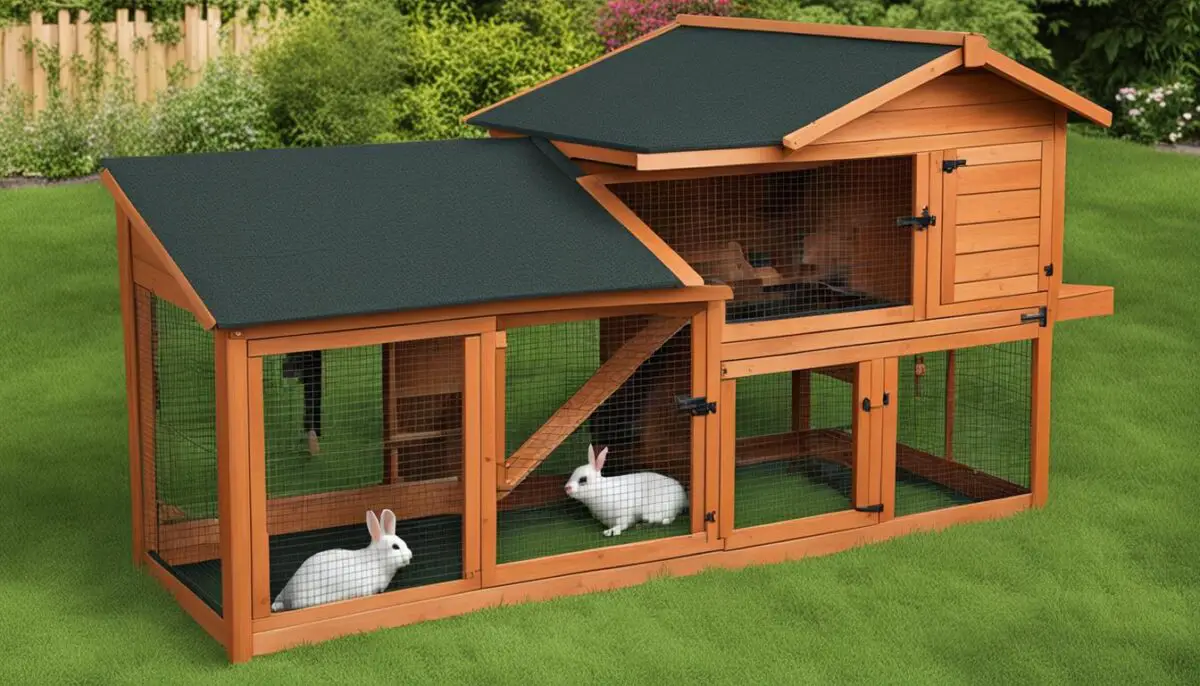
Whether you choose hutches or cages or colonies, it’s essential to prioritize the comfort, safety, and health of your meat rabbits. By providing them with suitable housing options, you can create an environment that allows them to thrive and reach their full potential.
Feeding and Care of Meat Rabbits
Feeding meat rabbits a balanced diet is crucial for their health and growth. A high-quality commercial rabbit pellet feed serves as the foundation of their diet, providing the necessary nutrients and vitamins they need to thrive.
Additionally, supplementing their diet with fresh food options such as garden scraps, herbs, and vegetables can enhance their overall health and wellbeing. These fresh food options not only provide additional nutrients but also offer a variety of flavors and textures, keeping the rabbits stimulated and satisfied.
“Proper nutrition is the key to raising healthy and productive meat rabbits. By providing a well-balanced diet, breeders can ensure optimal growth and development.”
Access to clean water is essential for meat rabbits. They should have a constant supply of fresh, clean water at all times. There are several options available for providing water to meat rabbits, including automatic watering systems and water bottles. These options ensure that the rabbits have access to clean water without the risk of contamination or spills.
Proper care for meat rabbits includes regular health checks, vaccinations, and maintaining proper hygiene. Regular health checks by a veterinarian can help identify any potential health issues early on and ensure that the rabbits receive timely treatment. Vaccinations are essential for protecting meat rabbits from common diseases.
As for hygiene, it’s important to keep the meat rabbit hutch clean and free from waste and debris. Regularly removing soiled bedding and providing fresh bedding helps maintain a clean and comfortable living environment for the rabbits. Cleanliness plays a vital role in preventing the spread of diseases and promoting the overall well-being of the rabbits.
Nutritional Requirements for Meat Rabbits
Meat rabbits have specific nutritional requirements to support their growth and productivity. Here are some key nutrients that should be included in their diet:
- Protein: Essential for muscle development and overall growth.
- Fiber: Aids in healthy digestion and prevents digestive issues.
- Vitamins and Minerals: Provide essential nutrients for overall health and immune system support.
Consult with a veterinarian or an experienced breeder to determine the specific nutritional needs of your meat rabbits and create a feeding plan that meets those requirements. Following a well-defined feeding regimen significantly contributes to the success of your meat rabbit breeding program.
Sample Feeding Schedule for Meat Rabbits
| Feeding Time | Feed Type | Quantity |
|---|---|---|
| Morning | Rabbit Pellet Feed | 1/4 cup |
| Afternoon | Fresh Vegetables | A handful |
| Evening | Rabbit Pellet Feed | 1/4 cup |
Note: The feeding schedule and quantities may vary depending on the age, weight, and specific requirements of the meat rabbits. Adjustments should be made accordingly to ensure proper nutrition and optimal growth.
By providing a well-balanced diet, regular health checks, and proper hygiene, you can ensure the care and well-being of your meat rabbits. Remember, healthy and well-nourished rabbits are more likely to thrive and produce quality meat for your breeding program.
Conclusion
Raising meat rabbits can be a rewarding and sustainable endeavor for breeders. To ensure the success of your breeding program, it is crucial to select the appropriate meat rabbit hutch. Factors such as durability, spaciousness, and meeting the specific needs of meat rabbits should be considered when choosing a hutch. This will provide a comfortable and secure environment for your rabbits to thrive.
Choosing the right meat rabbit breed is also an important aspect of successful rabbit breeding. Optimal meat to bone ratios and breeding capabilities can vary between breeds, so it is essential to select the breed that aligns with your goals and preferences.
Proper care and feeding are fundamental to the health and growth of meat rabbits. Providing a balanced diet, including high-quality commercial rabbit pellet feed and supplemented with fresh food options, ensures that your rabbits receive the necessary nutrients. Regular health checks, vaccinations, and maintaining proper hygiene are also essential for the overall well-being of your rabbits and the prevention of diseases.
By following these guidelines for meat rabbit hutch options, rabbit breeding, and meat rabbit care, breeders can ensure the success of their breeding program. Not only will this provide a sustainable source of meat for themselves, but it can also contribute to their communities’ food security and self-sufficiency.
FAQ
What factors should I consider when choosing a meat rabbit hutch?
When choosing a meat rabbit hutch, it’s important to consider factors such as durability, spaciousness, and meeting the specific needs of meat rabbits. Look for a hutch that provides enough room for the rabbits to move around comfortably and includes features like nesting boxes and ample ventilation.
What are the advantages of raising rabbits for meat?
Raising rabbits for meat offers several advantages, including their suitability for small spaces, making them ideal for urban and suburban environments. Rabbit cages and hutches are available in both indoor and outdoor options, providing flexibility in housing arrangements. They are also easy to clean, minimizing maintenance requirements.
How do I choose the right meat rabbit breed?
When choosing a meat rabbit breed, it’s essential to consider factors such as the meat to bone ratio, pelt quality, and breeding capabilities of the doe and buck. Popular meat rabbit breeds include New Zealands, Rex, Flemish Giants, Florida White, and Californians. The breed you choose will depend on your specific goals and preferences.
What is the gestational period for rabbits?
The gestational period for rabbits is around 29-32 days. Does should be given a rest period of 4-6 weeks between litters to regain strength and nurse their current litter.
What is the optimal age for butchering meat rabbits?
Meat rabbits typically reach optimal butchering weight between 8-14 weeks of age, depending on the breed. Crossbreeding larger breeds with smaller ones can help achieve the desired weight for fully dressed rabbits.
What are some excellent meat rabbit breeds to consider?
There are several excellent meat rabbit breeds to choose from, including New Zealand Whites, Rex, Flemish Giants, Florida White, American Chinchilla, Californians, Cinnamon, Champagne D’Argent, Harlequin, Standard Chinchilla, Satin, American Blue, Palomino, and Silver Fox.
What are the housing options for meat rabbits?
The main housing options for meat rabbits are hutches or cages, and colonies or natural environments. Hutches and cages provide a controlled and clean environment for rabbits, while colonies or natural environments allow rabbits more freedom to roam and engage in natural behaviors.
What should I feed meat rabbits?
Feeding meat rabbits a balanced diet is crucial for their health and growth. A high-quality commercial rabbit pellet feed is the foundation of their diet, supplemented with fresh food options such as garden scraps, herbs, and vegetables. Access to clean water is also essential.
How do I care for meat rabbits?
Proper care for meat rabbits includes regular health checks, vaccinations, and proper hygiene to prevent the spread of diseases. It’s important to ensure their hutch or cage is clean and comfortable, and to provide them with a balanced diet and ample water.


